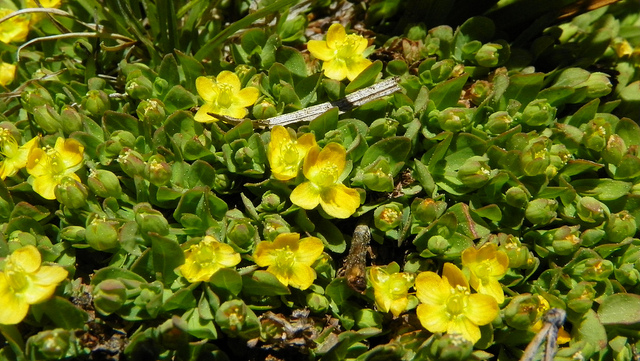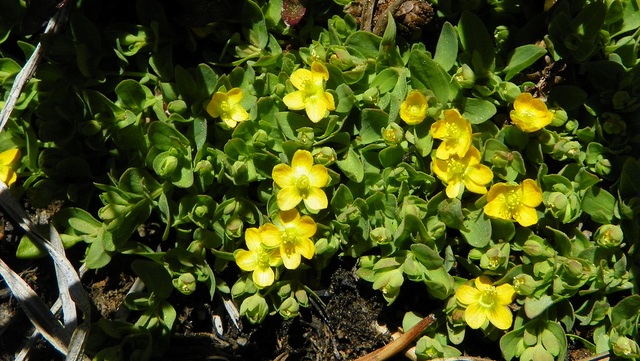Forums:
Hypericum anagalloides is a herbaceous mat forming ground cover, for a damp bog/fen sights. The dense bright green foliage is set off by golden yellow blossoms. This 1/2 inch tall gem is quite common across western North America. It's common name is "Tinker's Penny".
It is easily transplanted.
Hypericum anagalloides and Mimulus primuloides




Comments
Mark McDonough
Re: Hypericum anagalloides
Thu, 11/17/2011 - 6:57pmJohn, a cool little plant, as a die-hard Hypericum fan I'm embarrassed to admit I didn't know this groundcover species... I've been focusing in on the highly ornamental woody North American species (like H. frondosum and prolificum). I see that it has a widespread north-south distribution in western USA. In the 4 years that I lived in Washington State, I'm surprised that I did not encounter this plant.
http://plants.usda.gov/java/nameSearch?mode=sciname&keywordquery=Hyperic...
CalPhotos gallery link:
http://calphotos.berkeley.edu/cgi/img_query?query_src=photos_index&where...
John, can I assume you grow this plant based on the comment "it is easily transplanted". Any further comments on growing this prostrate species. How does it rate as a "spreader"... safe or something to keep an eye on?
Anonymous (not verified)
Re: Hypericum anagalloides
Thu, 11/17/2011 - 11:15pmMark, Here are some other interesting Hypericums.
Hypericum kalmianum - found in the Great Lakes Region in calcareous flats
Hypericum pyramidatum - found where fens grade into shrub thickets
Hypericum crux-andreae - This one does not grow in my area. I saw it once in the New Jersey Pine Barrens. It is the only member of the Rosaceae I know of that has four petals.
James
Richard T. Rodich
Re: Hypericum anagalloides
Fri, 11/18/2011 - 2:35amHypericum crux-andreae...
Had anyone told me that it had only four petals, I wouldn't have believed them.
Mark McDonough
Re: Hypericum anagalloides
Fri, 11/18/2011 - 6:50amResearching on these more, there are several North American species with the 4-petal arrangement. I didn't recognize the name H. crux-andreae, but looking it up I realized I was familiar with it under an earlier name, Hypericum stans.
Mark McDonough
Re: Hypericum anagalloides
Fri, 11/18/2011 - 6:59amThanks James, I've seen both H. kalmianum and pyramidatum in a garden in New Hampshire not far from me, some of the woody shrub Hypericum have very attractive peeling reddish bark too, really interesting plants, and valuable for mid summer bloom. I've grown a couple southeastern species that are superb rock-garden sized low matting shrubs, H. lloydii (needle-like leaves) and H. buckleyi. The latter I had in a former rock garden for years, whereas H. loydii is hard to establish this far north... I first admired it in the Boston garden of We-Du nursery guys Dick Weaver and Rene Duvall. H. reductum is another heath-like low shrubby species; isuch a fascinating genus.
In the topic entitled "Shrubby Hypericum - starting with H. frondosum", it was my intent to expand on the subject there, but you know how best intentions go, one gets busy, and then....
http://nargs.org/smf/index.php?topic=621.0
I do have some good photos of H. prolificum, a really terrific shrubby species, which I will post on at the topic-link given above.
John P. Weiser
Re: Hypericum anagalloides
Fri, 11/18/2011 - 7:23amMark I do grow it in a bed for fen plants. I don't find it weedy, it spreads moderately an inch or two a year forming a nice shallow rooted, sheet of foliage. It's stems are tender, and succulant like. through the years it's mats build up on the humus debris of previous seasons, forming little green mounds. It grows in full sun were there is a continuous source of surface moisture. (e.g. seeps, springs and stream banks).
It is a great filler plant and is lose enough to allow other species to sprout in to the mats. (e.g. Mimulus, Pedicularis or Platanthera ect.)
Trond Hoy
Re: Hypericum anagalloides
Fri, 11/18/2011 - 3:43pmWhat a treasure! Never heard of or read about it before. Do you know if it is easy from seed?
John P. Weiser
Re: Hypericum anagalloides
Fri, 11/18/2011 - 9:00pmI don't know. I took a rooted cutting.